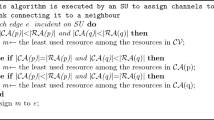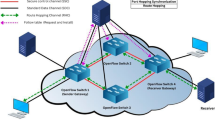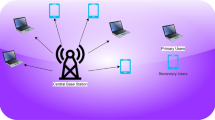Abstract
The network addresses of principals in a mobile ad hoc network (MANET) are conventionally assumed to be public information. This may cause devastating consequences for MANETs deployed in hostile environments. For example, attackers can easily locate a target principal based his known network address and then launch a pinpoint attack. This paper identifies address privacy as a new security requirement to prevent attackers from ascertaining network addresses of MANET principals. We further present Swarms, the first solution to satisfying this requirement. Swarms eliminates the conventionally explicit one-on-one mappings between MANET principals and network addresses and allows any two principals to communicate while blind to each other’s address. We quantitatively measure the address privacy offered by Swarms via an entropy-based information-theoretic metric.



Similar content being viewed by others
Notes
A keyed-hash message authentication code should be attached to each packet to ensure its integrity, but we ignore it for brevity.
\(AP_{\,d^s}(l=l_1)\) is defined to be zero for C ≥ L + l 1.
References
Gruteser M, Grunwald D (2005) Enhancing location privacy in wireless LAN through disposable interface identifiers. ACM Mob Netw Appl 10(3):315–325
Lou W, Fang Y (2003) A survey of wireless security in mobile ad hoc networks: challenges and available solutions. In: Chen X, Huang X, Du D-Z (eds) Ad hoc wireless networking. Kluwer Academic, New York
Zhang Y, Liu W, Lou W, Fang Y (2006) Securing mobile ad hoc networks with certificateless public keys. IEEE Trans Dependable Secure Comput 3(4):386–399
Zhang Y, Liu W, Lou W, Fang Y (2006) MASK: anonymous on-demand routing in mobile ad hoc networks. IEEE Trans Wireless Commun 5(9):2376–2385
Loguinov D, Kumar A, Rai V, Ganesh S (2003) Graph-theoretic analysis of structured peer-to-peer systems: routing distances and fault resilience. In: ACM SIGCOMM’03, Karlsruhe, August 2003, pp 395–406
Imase M, Itoh M (1981) Design to minimize diameter on building-block networks. IEEE Trans Comput C-30(6):439–442
Clausen T, Jacquet P (2003) Optimized link state routing protocol (OLSR), RFC 3626, Oct
Perkins C, Belding-Royer E, Das S (2003) Ad hoc on-demand distance vector (AODV) routing, RFC 3561, July
Bloom B (1970) Space/time trade-offs in hash coding with allowable errors. Comm ACM 13(7):422–426
Fan L, Cao P, Almeida J, Broder AZ (2000) Summary cache: a scalable wide-area web cache sharing protocol. IEEE/ACM Trans Netw (TON) 8(3):281–293
Díaz C, Seys S, Claessens J, Preneel B (2002) Towards measuring anonymity. In: Proc. Privacy Enhancing Technologies (PET 2002), ser LNCS, vol 2482. Springer, Heidelberg, pp 54–68
Cover TM, Thomas JA (2006) Elements of information theory, 2nd ed. Wiley-Interscience, New York
Acknowledgements
This work was supported in part by the US National Science Foundation under grants CNS-0716302 and CNS-0831963.
Author information
Authors and Affiliations
Corresponding author
Rights and permissions
About this article
Cite this article
Zhang, Y., Ren, K. On Address Privacy in Mobile Ad Hoc Networks. Mobile Netw Appl 14, 188–197 (2009). https://doi.org/10.1007/s11036-008-0142-5
Published:
Issue Date:
DOI: https://doi.org/10.1007/s11036-008-0142-5




